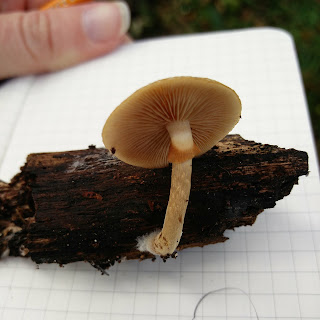We began with a poke around in the wood piles where we found various crusts and brackets, the usual suspects: Turkeytail Trametes versicolor, Birch Mazegill Lenzites betulina, Purplepore Bracket Trichaptum abietinum, Birch Woodwart Annulohypoxylon multiforme and Bitter Oysterling Panellus stipticus.
Conifer Blueing Bracket Postia caesia was a new one on me, and rather charming.
We also came across the Funeral Bell Galerina marginata growing here and there on bits of rotting wood.
There are lots of Galerina species but the ring around the stem makes this one quite distinctive. We also found this younger specimen, with its particularly neat-looking ring.
Moving on into an area of dense mixed woodland, we found quite a colony of Fenugreek Stalkball Phleogena faginea. I had to get my face right up against the bark to get a whiff of their curry-like scent.
There were masses of these around: Trooping Funnel Clitocybe geotropa.
Here's a rather slug-eaten pair, showing the deeply decurrent gills (or what's left of them).
Growing in an area with Birch, we came across this rather statuesque milkcap which Nick Aplin identified as Wooly Milkcap Lactarius torminosus.
The wooly hairs on the cap and margin are characteristic of this species.
I think we decided this was Brown Birch Bolete Leccinum scabrum.
There was no colour change in the flesh, upon being cut.
In this area of woodland we also came across a lone Slimy Waxcap Hygrocybe irrigata. So slimy I couldn't put it down! (I'll never get tired of this trick.)
I got super excited when we found these tiny orange blobs on a log, because I LOVE these. They're fruit bodies of the slime mould Hemitrichia calyculata.
Luckily Mark Colvin was with us, of Secret Nature fame, and he got this super shot of them. Aren't they gorgeous!
 |
| Image © Mark Colvin. |
Clare Peters found this Wood Blewit Lepista nuda.
This species has really beautiful lilac colour to the gills when young.
The lilac cap will gradually turn buff-brown with age.
The Collins (illustrated) Fungi Guide describes Wood Blewit Lepista nuda as widespread and very common, but I don't think I've come across it before.
There were lots of Clouded Funnel Clitocybe nebularis dotted around. This species is starting to feel quite familar to me now, as I've seen it all over the place this year.
And an exciting find – because I like grisettes – was Snakeskin Grisette Amanita ceciliae. The pale grey-brown, white-flecked stem is characteristic of this species.
The cap is covered in dingy grey, warty patches of volva and it has the striate margin which is a feature of the grisettes.
We did manage to re-find the rare Chlorencoelia versiformis which we discovered on our foray here last year (photo here). But it was looking a bit past it.
We also found an amazing little fungus which got dubbed 'Tiny Tube Thing', until Nick Aplin remembered it's called Henningsomyces candidus. There's an article about this species on the Cornell Mushroom Blog (here) which describes the fruit body as looking like miniature macaroni. So true!
For the record
Date: 29 October 2017
Location: Private site near Northchapel
All records to be submitted by Nick Aplin, Sussex Fungus Group



















No comments:
Post a Comment